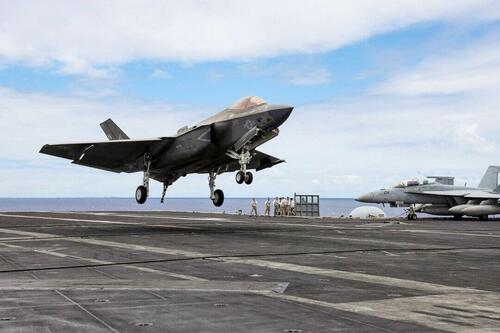Report Finds US Military Lacks Ability To Defeat China, Suggests Cold War Style Defense Spending
Authored by Andrew Thornebrooke via The Epoch Times (emphasis ours),
A new congressional report suggests that the U.S. military lacks the required capabilities to preserve the nation’s strategic interests and could lose a potential war against China.
The report, published on July 30 by the Commission on the National Defense Strategy, found that “the U.S. military lacks both the capabilities and the capacity required to be confident it can deter and prevail in combat.”
“The Commission finds that the U.S. defense industrial base (DIB) is unable to meet the equipment, technology, and munitions needs of the United States and its allies and partners,” the report reads.
Eric Edelman, who serves as vice chair for the commission, told the Senate Armed Services Committee on Tuesday that China’s communist regime was outpacing the United States in military development.
He said that fact could increase the likelihood of a conflict between the two powers and the likelihood of the United States losing.
“There is potential for a near-term war and a potential that we might lose such a conflict,” Mr. Edelman said.
“We found that China is in many ways outpacing the U.S.,” he said. “While we still have the strongest military in the world with the farthest global reach, when we get to 1,000 miles of China’s shore, we start to lose our military dominance and could find ourselves on the losing end of a conflict.”
To that end, Mr. Edelman underscored that the growing strategic partnerships between China, Iran, North Korea, and Russia were a “major strategic shift” that U.S. defense planners failed to fully account for.
He said that with those four authoritarian regimes working together against the United States in an unprecedented way, the United States could face a global conflict that would stretch all of its national resources thin.
“It makes each of those countries potentially stronger militarily, economically, and diplomatically, and potentially can weaken the tools we have at our disposal to deal with them,” Mr. Edelman said.
“And it makes it more likely that a future conflict, for instance in the Indo-Pacific, would expand across other theaters, and that we would find ourselves in a global war that is on the scale of the Second World War.”
Therefore, the Commission’s report calls on Congress and the various government departments to “rewrite laws and regulations to remove unnecessary barriers to adopting innovation, budgeting, and procurement” in pursuit of increased deterrence.
Likewise, the report recommends that the national strategy be radically transformed by moving away from the “bipolar” Cold War strategic model to a “multi-theater model” that accounts for the fact that the United States could face armed conflicts against multiple nation states across the globe simultaneously.
Time is not on the United States’ side, the report says, and China is likely to increase its hostile behavior in the coming years in an effort to “normalize unlawful behavior” as it pursues “establishing advantageous conditions for future coercion or conflict.”
The report does not equivocate on the issue. If changes are not made to the national strategic posture, the armed wing of China’s communist rulership, the People’s Liberation Army (PLA), will likely surpass the strength of the U.S. military.
“If these trends continue, the PLA will be a peer, if not superior, military competitor of the United States across domains, a situation the United States has not faced since the height of the Cold War,” the report reads.
Commission Chair Jane Harman told the committee the United States should synthesize all instruments of its power, including private industries, to propel military innovation and the adoption of new technologies.
In order to achieve this, the report calls for increasing taxes to expand U.S. defense spending to Cold War levels, which it suggests fell between 4.9 and 16.9 percent of GDP.
Assuming the United States maintains its 2023 GDP of about $27 trillion, that would mean an annual defense budget of at least $1.3 trillion to as much as $4.5 trillion, though the report says that advances in commercial technologies would reduce the cost burden compared to the Cold War era.
“We found that the joint force is at the breaking point of maintaining readiness today. Adding more burden without adding resources to rebuild readiness will cause it to break,” Ms. Harman said.
“We recommend fundamental change in the way the Pentagon and other government agencies do business, the way they incorporate private sector technology, and a full embrace of our partners and allies. Shorthand for this is we recommend using all elements of national power.”
Tyler Durden
Wed, 07/31/2024 – 20:50

